英语国家社会习俗第七章 餐桌礼仪
(完整版)中国餐桌礼仪英文版

Eat with little noise and movement
Help people to dish the serving chopsticks ,centiliter ,not use yours
Qing Dynasty by the impact of Western food, some Western rituals have also been introduced. Such as sub-dishes, on the soup, into the wine, etc, because of reasonable health way, it was introduced into the Chinese etiquette.
Had better not pick your teeth. If you must do it ,you should screen your mouth with napin or your hands
Leave the feast
When you leave the feast,you should show your thank to the master , or invite the master to your house here after.
Lead the guest to the seat of honor,then lead the senior to the seae next to the guest
Take the seat from left
Do not start eating in a hurry or make noise
餐桌礼仪英文版

→
For ladies
The skills of slicing meat (such as beef)
fxtà|Çz tÜÜtÇzxÅxÇàá guest of the
honor woman
↗
male Host female male female female male Hostess
↗
the guest of honor man
The order of dishes in the West
Dinner start with a small dish, which is often called an a starter .After the starter you will get a bowl of soup.The next dish is the main course,it usually is a beefsteak . A vegetable salad will be served.Then a delicious dessert will appear at the table .At last is a cup of tea or coffee.
HELPING YOURSELF AND REFUSING
If a servant passes food around, he will pass the dish in at your left hand so that you can conveniently serve yourself with your right hand. Never serve yourself while the dish is on your right; it is then the turn of your neighbor on the right. It is polite to take some of everything that is passed to you. But if there is something you may not like, you may quietly say: "No thank you.“
英文版中国餐桌礼仪

Second :manners at mealtimes
• Don't eat until everyone is there. Don't reach to get the food on the opposite side. • Ask the visitor and the elder to move the chopsticks first. • The hosts should help the guests to the food or ask them to help themselves. • Eat with little noise and movement. Do not make a hiccup (打嗝) or a sound like a hiccup. • You may not slurp(出声地吃喝)your soup.
after take the seat, keep a proper posture;
keep your feet under your seat, don’t
straighten or step
under others’
seats;
don’t keep your elbows(肘部)to the edge of the table or put your hands on another chair’s back .
Definitude the primary mission of the meal. If it is a business meal, together to communicate with each other. However if it is only to make friendly contacts, what you need to do is just
关于餐桌礼仪的英语作文带翻译

关于餐桌礼仪的英语作文带翻译Table manners are an essential aspect of social etiquettethat can significantly impact how others perceive us. They are a set of behaviors and customs that are considered to be polite and socially acceptable while eating. In English, the term "table manners" encompasses a variety of practices that vary from one culture to another, but there are some universal principles that are widely recognized.Firstly, cleanliness is a fundamental aspect of good table manners. Before a meal, it is polite to wash one's hands. During the meal, it is important to keep your hands clean and use a napkin to wipe your mouth if necessary.Secondly, the way one uses cutlery is a clear indicator of one's table manners. In English-speaking countries, the principle of "fork in the left hand and knife in the right" is commonly followed. When you finish eating, it is customary to place your cutlery together on the plate to signal that you are done.Thirdly, being considerate of others is a hallmark of good manners. This includes waiting for everyone to be served before you start eating, not making loud noises while eating, and not reaching across the table for items.Lastly, communication during a meal is also a part of table manners. Engaging in polite conversation, listeningattentively when others are speaking, and avoiding controversial topics can make for a pleasant dining experience.In conclusion, table manners are not just about following aset of rules; they are about showing respect andconsideration for others. They can enhance socialinteractions and are a reflection of one's upbringing and cultural awareness.翻译:餐桌礼仪是社交礼仪的重要组成部分,可以显著影响他人对我们的看法。
英语餐桌礼仪PPT
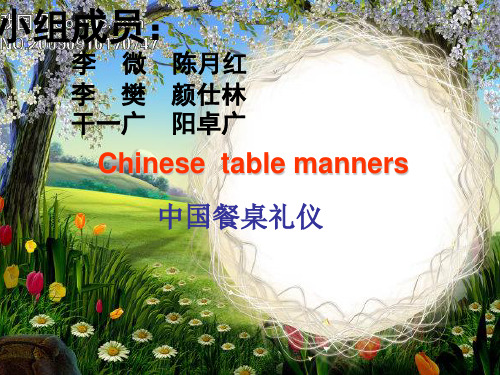
Chinese table manle manners 2 Dining etiquette 3 Leaving the etiquette
Chinese table manners
• One seat etiquette. First call the guests seated on the seats, please turn seated next to the seated guests for the elderly, the seat from the chair on the left to enter. Admission Dongkuaizi not after, not to come to beep, and do not get up walk.
如果要给客人或长辈布菜.最好 用公筷.也可以把离客人或长辈远的 菜肴送到他们跟前,按我们中华民族 的习惯.菜是一个一个往上端的.如 果同桌有领导,老人,客人的话.每当 上来一个新菜时就请他们先动筷子. 或着轮流请他们先动筷子.以表示对 他们的重视.
Eat the fish head and bones, bones and other things, not to spit out, also don't want to still on the ground. To slowly to their dishes by hand, or placed in close to the table or on the prepared sheet.
入座的礼仪。先请客人入 座上席,在请长者入座客 人旁依次入座,入座时要 从椅子左边进入。入座后 不要动筷子,更不要弄出 什么响声来,也不要起身 走动。
Seated posture straight, feet on my seat, not arbitrary straight, elbows shall not rely on the table, or put the hand on the next to the seat.
各国的餐桌礼仪英文版
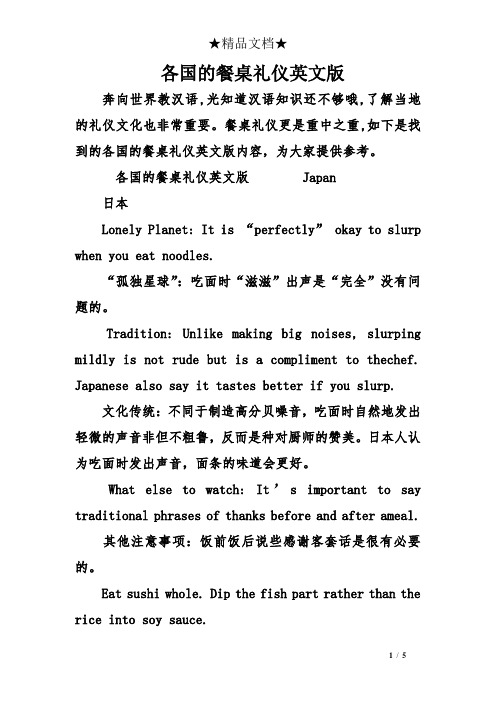
各国的餐桌礼仪英文版奔向世界教汉语,光知道汉语知识还不够哦,了解当地的礼仪文化也非常重要。
餐桌礼仪更是重中之重,如下是找到的各国的餐桌礼仪英文版内容,为大家提供参考。
各国的餐桌礼仪英文版Japan日本Lonely Planet: It is “perfectly” okay to slurp when you eat noodles.“孤独星球”:吃面时“滋滋”出声是“完全”没有问题的。
Tradition: Unlike making big noises, slurping mildly is not rude but is a compliment to thechef. Japanese also say it tastes better if you slurp.文化传统:不同于制造高分贝噪音,吃面时自然地发出轻微的声音非但不粗鲁,反而是种对厨师的赞美。
日本人认为吃面时发出声音,面条的味道会更好。
What else to watch: It’s important to say traditional phrases of thanks before and after ameal.其他注意事项:饭前饭后说些感谢客套话是很有必要的。
Eat sushi whole. Dip the fish part rather than the rice into soy sauce.寿司要一口吃掉。
应该用鱼生的部分来蘸取酱油,而不是米饭的部分。
Russia俄罗斯Lonely Planet: Your wrists should be placed on the edge of the table while eating, fork in lefthand, knife in the right.“孤独星球”:用餐时手腕要放在桌子边缘,左手拿叉,右手拿刀。
Tradition: Keep your hands in sight. It is not good manners to rest them on your lap. Keepyour elbows off the table.文化传统:双手要保持在别人的视线内。
英国人的餐桌礼仪

英国人的餐桌礼仪 ●进门后由领座员引导入座。
●试饮葡萄酒时,先端起酒杯,如味道极差,可拒绝试饮。
在饮料送来前将餐巾置於大腿。
●将餐单从头看一遍再点菜,可先叫饮料,再慢慢看。
●食用面包时,应用手指每次撕一小块。
●从外至里依次使用排好的刀叉。
●吃东西时切勿发出声音。
●闭着嘴咀嚼食物,勿使食物露出。
●吃有骨头的肉时,可以用手拿着吃。
若想吃得更优雅,还是用刀较好。
用叉子将整片肉固定(可将叉子朝上,用叉子背部压住肉),再用刀沿骨头插人,把肉切 开。
最好是边切边吃。
。
●吃面包可蘸调味汁,吃到连调味汁都不剩,是对厨师的礼貌。
注意不要把面包盘子“舔得很干净,而要用叉子叉住已撕成小片的面包,再蘸一点调味汁 来吃,是雅观的作法。
●弄脏嘴巴时,一定要用餐巾擦拭,避免用自己的手帕。
用餐反摺的内侧来擦,而不是弄脏其正面。
手指洗过后也是用餐巾擦的。
若餐巾脏得厉害,请侍者重新更换一条。
●在一流餐厅里,客人除了吃以外,诸如倒酒、整理餐具、捡起掉在地上的刀叉等事,都 应让侍者去做。
在国外,进餐时侍者会来问:“How is everything?如果没有问题,可用“Good 来表达满 意。
●在餐厅吃饭时就要享受美食和社交的乐趣,沉默地各吃各的会很奇怪。
但旁若无人地大声喧哗,也是极失礼的行为。
音量要小心保持对方能听见的程度,别影响到邻桌。
●中途离席时将餐巾放在椅子上万不得已要中途离席时,最好在上菜的空档,向同桌的人 打声招呼,把餐巾放在椅子上再走,别打乱了整个吃饭的程序和气氛。
吃完饭后,只要将餐巾随意放在餐桌即可,不必特意叠整齐。
●上甜点之前,会送上一个大托盘,摆满数种乳酪、饼干和水果,挑多少种都可以,但以 吃得下的范围为准。
用叉子和汤匙吃甜点上甜点时大都会附上汤匙和叉子。
冰淇淋之类的甜点容易滑动,可用叉子固定并集中,再放到汤匙里吃。
大块的水果可以切成一口的大小,再用叉子叉来吃。
关于中国餐桌礼仪英语作文(精选10篇)

中国餐桌礼仪英语作文关于中国餐桌礼仪英语作文(精选10篇)中华饮食源远流长。
在这自古为礼仪之邦,讲究民以食为天的国度里,饮食礼仪自然成为饮食文化的一个重要部分。
下面是yuwenmi 小编为大家整理的关于中国餐桌礼仪英语作文(精选10篇),欢迎阅读与借鉴,谢谢。
中国餐桌礼仪英语作文篇1As we all know,different countries have different table manners. T oday, I’d like to introduce something about Chinese table manners. It’s very necessary to learn table manners in China. In China, table manners are too much. For instance,you are not supposed to eat with knives and forks. Chinese usually use chopsticks instead. But we are not supposed to stick our chopsticks into our food. But we are supposed to pick up our bowl to eat. And we are supposed to let the old start eating first.And we are allowed to talk at the table. However, yo u can’t talk too loud and laugh too crazily. In fact, in China, table manners are not so serious . so , you don’t need to worry about them so much.【参考译文】我们都知道,不同的国家有不同的餐桌礼仪。
餐桌礼仪英文版

餐桌礼仪英文版餐桌礼仪英文版英文版的西餐餐桌礼仪Eating in American(II)美国人吃饭用刀叉,而且他们的用餐方式是很有讲究的。
因此,在应邀与美国朋友一起吃饭时,应特别注意他们的用餐习惯。
一般情况下,餐桌上摆放有一幅餐刀和两幅餐叉,外边的餐叉供你吃色拉,里边的.餐叉用于吃主食和其它点心食品,餐刀用来切肉食。
如果你两手并用,应左手握叉,右手握刀,而且一次握刀时间不能太长。
美国人的早餐有:炒或煮鸡蛋、香肠、油炸土豆片、薄煎饼、果子冻、烤面包、松饼、桔子汁以及咖啡等。
Eating Custom and Practice 用餐习惯American eating is funny.They eat almost everything with a fork,and it appears that holding a knife in one's right hand longer than a few seconds is considered to be against good table manners.The system is that if it is absolutely necessary to use a knife,people take the fork in their left hand,and cut off a piece of meat or whatever it is in the normal manner.Then they put the knife down,transfer the fork to their right hand,and only then do they transport the food to their mouth.This is clearly ludicrous(滑稽可笑),but it is considered good manners.There are several results of this system.First,if it is not absolutely necessary to use a knife,Americans don't use one,because obviously this greatly complicates(使复杂化)things,and you will therefore see them trying to cut things like potatoes,fish and even bacon(熏猪肉)with a fork.Second,towardsthe end of a course,since only one implement(器具)is being used,food has to bo chased around the plate with the fork —and for the last mouthful the thumb has to be used to keep the food in place,although one is not supposed to do this.Third,tables are generally laid with one knife and two forks,the outside fork being for the salad.There is no need for foreign visitors to follow the American system and try to eat the salad with only a fork,but if you do use your knife,remerber to save it for the meat course.Even desserts(甜食)(except ice cream)are eaten with a fork if at all possible,and the spoon you see by your dessert is meant to be for coffee (but if you use it for your dessert no one will say anything).Some Breakfast Dishes 早餐食谱Breakfast in a restaurant is a very enjoyable experience.If you order eggs in a restaurant,the waiter/waitress will ask you how you want them .You can reply that you want them "scrambled(炒)"or "boiled".It is not sufficient,however,to ask for them "fried"you will have to specify whether you would prefer them "sunny-side-up"(煎一面),"over"(两面煎),"over-easy/easy-over"(两面煎,但蛋黄仍然呈流体状).American sausage(香肠)comes in slices and is quite spicy.But you can also have link sausage.American bacon comes in small strips,can be rather fat,and is served crispy.It is usually very tasty,and you can eat it with your fingers."Hash brows"(油炸土豆片)are shredded(切成碎片的)and fried potatoes.They are wonderful,especially with fried eggs and ketchup(蕃茄酱)."Pancakes",sometimes called "hot cakes",are made with baking power.They are normally served in a pile,and you aresupposed to put butter and syrup(果浆)on them."Jelly"(果子冻)is jam and includes grape jelly,which is very tasty.Toast is often served already buttered."English muffins(松饼)"are like small crumpets(烤饼)without the holes and are served toasted.You put jam on them.A "biscuit"(软饼)is a snall,scone-like bread roll,often served hot.Orange juice and coffer are often serced with breakfast.不可不知的10条餐桌礼仪1. When helping a woman pull her chair to the table, hold it and guide it. Don’t shove it against the back of her legs.1.为女士拉椅子的时候,要把椅子抓住了,留个角度,让女士好走过去。
各国的餐桌礼仪英语
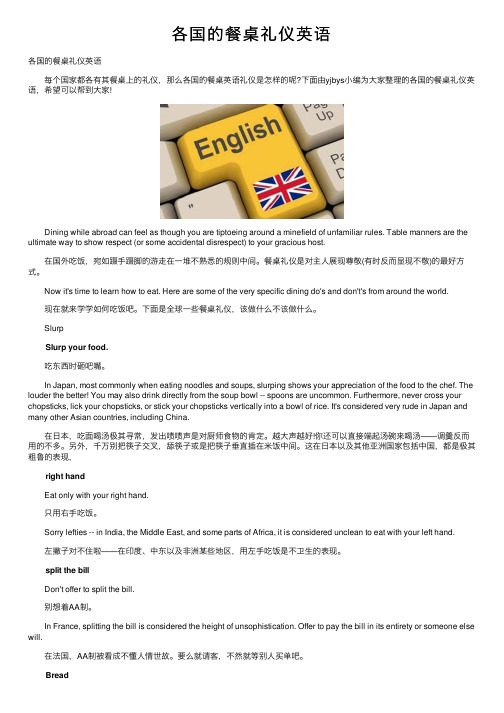
各国的餐桌礼仪英语各国的餐桌礼仪英语 每个国家都各有其餐桌上的礼仪,那么各国的餐桌英语礼仪是怎样的呢?下⾯由yjbys⼩编为⼤家整理的各国的餐桌礼仪英语,希望可以帮到⼤家! Dining while abroad can feel as though you are tiptoeing around a minefield of unfamiliar rules. Table manners are the ultimate way to show respect (or some accidental disrespect) to your gracious host. 在国外吃饭,宛如蹑⼿蹑脚的游⾛在⼀堆不熟悉的规则中间。
餐桌礼仪是对主⼈展现尊敬(有时反⽽显现不敬)的最好⽅式。
Now it's time to learn how to eat. Here are some of the very specific dining do's and don't's from around the world. 现在就来学学如何吃饭吧。
下⾯是全球⼀些餐桌礼仪,该做什么不该做什么。
Slurp Slurp your food. 吃东西时砸吧嘴。
In Japan, most commonly when eating noodles and soups, slurping shows your appreciation of the food to the chef. The louder the better! You may also drink directly from the soup bowl -- spoons are uncommon. Furthermore, never cross your chopsticks, lick your chopsticks, or stick your chopsticks vertically into a bowl of rice. It's considered very rude in Japan and many other Asian countries, including China. 在⽇本,吃⾯喝汤极其寻常,发出啧啧声是对厨师⾷物的肯定。
餐桌礼仪(中英文)
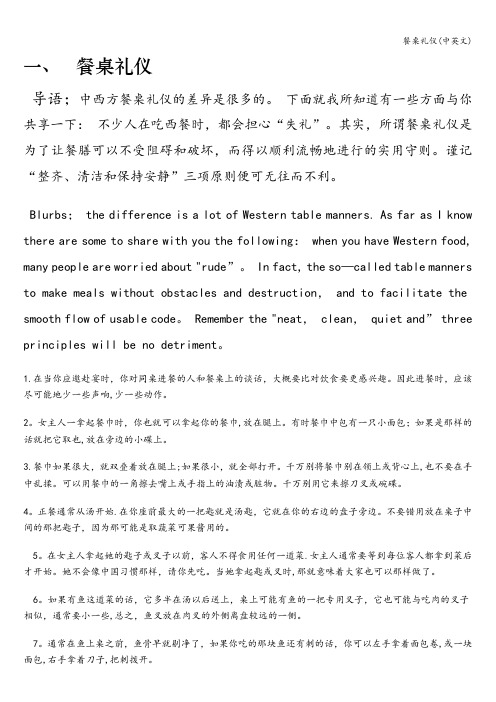
一、餐桌礼仪导语;中西方餐桌礼仪的差异是很多的。
下面就我所知道有一些方面与你共享一下:不少人在吃西餐时,都会担心“失礼”。
其实,所谓餐桌礼仪是为了让餐膳可以不受阻碍和破坏,而得以顺利流畅地进行的实用守则。
谨记“整齐、清洁和保持安静”三项原则便可无往而不利。
Blurbs; the difference is a lot of Western table manners. As far as I know there are some to share with you the following: when you have Western food, many people are worried about "rude”。
In fact, the so—called table manners to make meals without obstacles and destruction, and to facilitate the smooth flow of usable code。
Remember the "neat, clean,quiet and” three principles will be no detriment。
1.在当你应邀赴宴时,你对同桌进餐的人和餐桌上的谈话,大概要比对饮食要更感兴趣。
因此进餐时,应该尽可能地少一些声响,少一些动作。
2。
女主人一拿起餐巾时,你也就可以拿起你的餐巾,放在腿上。
有时餐巾中包有一只小面包;如果是那样的话就把它取也,放在旁边的小碟上。
3.餐巾如果很大,就双叠着放在腿上;如果很小,就全部打开。
千万别将餐巾别在领上或背心上,也不要在手中乱揉。
可以用餐巾的一角擦去嘴上或手指上的油渍或脏物。
千万别用它来擦刀叉或碗碟。
4。
正餐通常从汤开始.在你座前最大的一把匙就是汤匙,它就在你的右边的盘子旁边。
不要错用放在桌子中间的那把匙子,因为那可能是取蔬菜可果酱用的。
中国的餐桌礼仪英文版
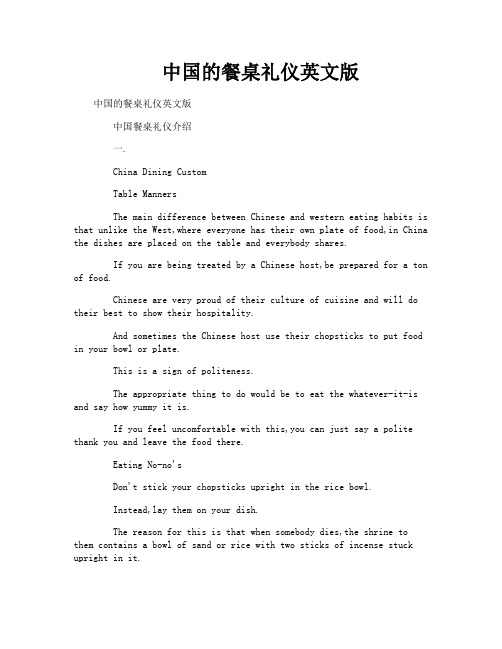
中国的餐桌礼仪英文版中国的餐桌礼仪英文版中国餐桌礼仪介绍一.China Dining CustomTable MannersThe main difference between Chinese and western eating habits is that unlike the West,where everyone has their own plate of food,in China the dishes are placed on the table and everybody shares.If you are being treated by a Chinese host,be prepared for a ton of food.Chinese are very proud of their culture of cuisine and will do their best to show their hospitality.And sometimes the Chinese host use their chopsticks to put food in your bowl or plate.This is a sign of politeness.The appropriate thing to do would be to eat the whatever-it-is and say how yummy it is.If you feel uncomfortable with this,you can just say a polite thank you and leave the food there.Eating No-no'sDon't stick your chopsticks upright in the rice bowl.Instead,lay them on your dish.The reason for this is that when somebody dies,the shrine to them contains a bowl of sand or rice with two sticks of incense stuck upright in it.So if you stick your chopsticks in the rice bowl,it looks like this shrine and is equivalent to wishing death upon a person at the table!Make sure the spout of the teapot is not facing anyone.It is impolite to set the teapot down where the spout is facing towards somebody.The spout should always be directed to where nobody issitting,usually just outward from the table.Don't tap on your bowl with your chopsticks.Beggars tap on their bowls,so this is not polite.Also,when the food is coming too slow in a restarant,people will tap their bowls.If you are in someone's home,it is like insulting the cook.DrinkingGan Bei!(Cheers!“Gan Bei” literally means “dry [the] glass”) Besides beer,the official Chinese alcoholic beverage is Bai Jiu,high-proof Chinese liquor made from assorted grains.There are varying degrees of Bai Jiu.The Beijing favorite is called Er Guo Tou,which is a whopping 56% alcohol.More expensive are Maotai and Wuliangye二.In China, as with any culture, there are rules and customs that surround what is appropriate and what is not when dining, whether it is in a restaurant or in someone’s home.Learning the appropriate way to act and what to say will not only help you feel like a native, but will also make those around you morecomfortable, and able to focus on you, instead of your interesting eating habits.同其他国家文化一样,在中国,无论是在餐馆还是在家,用餐时也有很多禁忌。
中西方餐桌礼仪 英文介绍
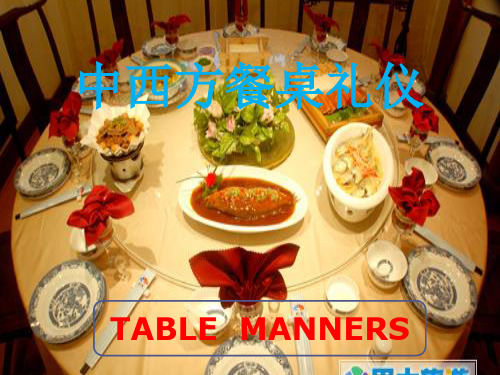
Talk with your mouth full
满口食物时讲话
Chew with your mouth opened
咬食物时把嘴巴张开
•喝汤时,用汤匙一小口一小口地喝,不宜把碗端到嘴边喝, 汤太热时不要一边吹一边喝,等凉了以后再喝。有的人 吃饭喜欢用咀嚼食物.特别是使劲咀嚼脆食物,发出很清 晰的声音来.这种做法是不合礼仪要求的,特别是和众人 一起进餐时,就要尽量防止出现这种现象。
西方进餐礼仪
——面包篇
•位置:
通常主菜未上桌前,服务生会先提供餐包,放的 位置一定是在主菜左侧,所以餐具左侧的面包是属于 你的,不要拿错。吃面包时,直接在面包盘上剥开、 涂抹奶油,否则离开面包盘,面包屑容易掉得满桌都 是,不易收拾。
西方进餐礼仪
——面包篇
•涂抹法:
Break the bread with your fingers into small piece small enough for one bite, butter it 用手指把面包一小块的撕开 来, 涂黄油
如果要给客人或长辈 布菜.最好用公筷.也可以 把离客人或长辈远的菜肴 送到他们跟前,按我们中华 民族的习惯.菜是一个一个 往上端的.如果同桌有领导, 老人,客人的话.每当上来 一个新菜时就请他们先动 筷子.或着轮流请他们先动 筷子.以表示对他们的重视.
吃到鱼头,鱼刺,骨头 等物时,不要往外面吐, 也不要往地上仍.要慢慢 用手拿到自己的碟子里, 或放在紧靠自己餐桌边 或放在事先准备好的纸 上
Put up the bowl Don't stick the chopsticks upright in the bowl.
DON’T
Slurp when drinking soup or eating noodles
英语作文餐桌礼仪
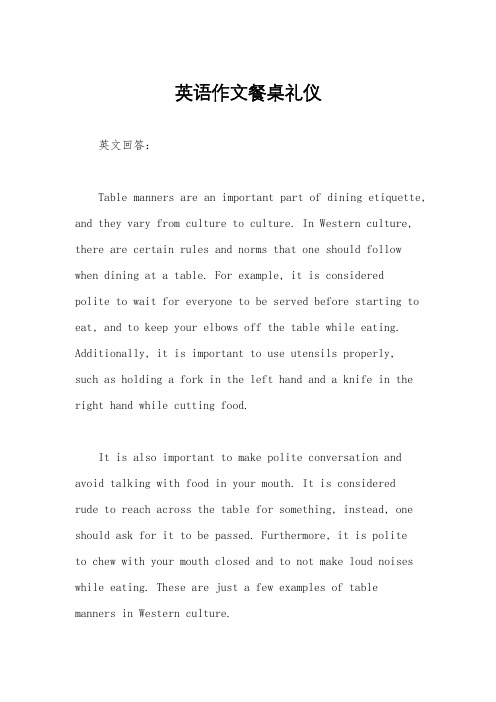
英语作文餐桌礼仪英文回答:Table manners are an important part of dining etiquette, and they vary from culture to culture. In Western culture, there are certain rules and norms that one should follow when dining at a table. For example, it is consideredpolite to wait for everyone to be served before starting to eat, and to keep your elbows off the table while eating. Additionally, it is important to use utensils properly,such as holding a fork in the left hand and a knife in the right hand while cutting food.It is also important to make polite conversation and avoid talking with food in your mouth. It is consideredrude to reach across the table for something, instead, one should ask for it to be passed. Furthermore, it is politeto chew with your mouth closed and to not make loud noises while eating. These are just a few examples of table manners in Western culture.中文回答:餐桌礼仪是用餐时非常重要的一部分,而且在不同的文化中也有不同的习惯和规矩。
餐桌礼仪英语

餐桌礼仪英语Paraction。
Youdon’thavetogoquickly, and you don’ t have to go slowly。
What’ s the last thing you have to do when you’re eating?Why don’ t you put your spoon or fork down?And why are there some leaves on the table?Why are you throwing them out? And what’ s the matter with the fruit? Why are you not picking it up?During the meal, there should be no one on the table who hasn’ t taken off their glasses。
You must never stand at the table at the same time as you are eating。
It is rude, and it makes you look bad。
A few people will leave a big mess if you are not careful。
They will come back at the same time and you will be a mess for a long time。
When we eat in China, our eyes must not be held up by the glasses。
When eating, our eyes should stay closed。
When eating, we must not eat too much or too fast。
中西方餐桌礼仪 英文介绍

TABLE MANNERS
1 入座的礼仪 table etiquette 2 进餐时的礼仪 meal etiquette 3 离席时的礼仪 when asked the etiquette
table etiquette
•Make the elders have a sit first
将骨头吐到餐纸上,再将骨头 包覆在纸内,这样才不会带给主人 难堪。
西方进餐礼仪
——刀叉篇
•吃到中途离席,刀叉该如何放?
应该把刀叉朝八字型放置, 刀口朝内、叉齿朝下。
西方进餐礼仪
——刀叉篇
•吃完后,刀叉该如何放?
左:应放在四点钟位置。 右:应将刀叉重迭,这样方便服务生 收时,不至于因为刀叉碰撞而发 出声响,或是刀叉掉落的意外。
擦鼻子
餐巾有分正反面,通常有 印该店LOGO的为正面,要 用反折的内侧来擦,擦完 盖在餐巾内侧不外露.
西方进餐礼仪
——餐巾篇
•暂时离席餐巾放哪里?
Place the napkin on the chair if you need to be excused.
。
西方进餐礼仪
——餐巾篇
• 用餐完毕准备离席,餐巾应该放在哪里?
西方进餐礼仪
——餐巾篇
• 餐巾万一不小心滑下去怎么办?
西方进餐礼仪
——餐巾篇
• 想擦嘴时该怎么办? 错误:用纸巾擦。 正确:Use the napkin to gently wipe your mouth. Don’t blow your nose into your napkin 餐巾只用作轻擦嘴边。不cksuprightbowlputupbowllnkingsoupeatingnoodles喝汤和吃面条时发出声音keepspooninsidecup勺儿留在汤碗或茶杯里talkyourmouthfull满口食物时讲话chewyourmouthopened咬食宜把碗端到嘴边喝汤太热时不要一边吹一边喝等凉了以后再喝
- 1、下载文档前请自行甄别文档内容的完整性,平台不提供额外的编辑、内容补充、找答案等附加服务。
- 2、"仅部分预览"的文档,不可在线预览部分如存在完整性等问题,可反馈申请退款(可完整预览的文档不适用该条件!)。
- 3、如文档侵犯您的权益,请联系客服反馈,我们会尽快为您处理(人工客服工作时间:9:00-18:30)。
• 一般要等到每一个人都拿到了食物以后,大家一起开始吃。在别人还 没有拿到食物以前,不应该擅自开始先吃;除非那些还没有拿到食物 的人士请你不要等候,你才可以先吃。 One does not start eating until every person is served or those who have not been served request that you begin without waiting. • 餐巾是放在膝盖上的。在正式的宴会中,客人要等主人把他(她)的 餐巾放到膝盖上之后,才把自己的餐巾放上。 Napkins are placed in the lap. At more formal occasions diners will wait to place their napkins on their laps until the host places his or h er napkin on his or her lap) • 在正式的宴会上,食物应该同时送到餐桌上的每一位,但还是要等主 人拿起餐具之后客人才能拿起餐具进餐。 At more formal occasions all diners should be served at the same ti me and will wait until the hostess or host lifts a fork or spoon before beginning) • 如果你不能吃某些食品,在你作客的时候,(如果主人不是你的亲 戚,)不应要求主人为你另外再增添你要吃的食品。 Even if one has dietary restrictions, it is inappropriate for non relatives to request food other than that which is being served by the host at a private function.
•
中国人向来“以食为先”,饮食除了是满足人的基本需求,亦是 秉承传统习俗,聚首饭桌前大快朵颐。设宴的原因可以是庆贺,也可 以是哀痛。每逢农历新年、结婚、中国节日如中秋节等,中国人便会 一家老少聚首饭桌前共贺佳节;但另方面,若有人离世,丧家会在葬 礼完成后设“解慰酒”,宴请出席葬礼的亲戚朋友,向他们表示谢意, 可见中国人十分重视聚首饭桌前分享喜乐与悲哀。古老与传统秉承的 中国文化造就了独特的中国餐桌礼仪,同样,西方的餐桌礼仪也如人 类文化遗产中的瑰宝和明珠,无比绚烂夺目,熟悉西方的餐桌礼仪, 才能更好地与他们交流,也才能更好得去发扬自己国家的文化与传统, 才能走向世界,走得更远。
第一节 美国
1.饭前(Before dining)
餐桌上都不应该戴帽子;在白天拜访别人的时候女士专用的帽子例外。 Men's and unisex hats should never be worn at the table. Ladies' hats may be worn during the day if visiting others. 在正式的宴会中,男士们须站在自己的座位后面,等女士们都坐下了以后,才 能坐下。 Before sitting down to a formal meal, gentlemen stand behind their chairs until t he women are seated. 在开始吃饭前,主人要做饭前的谢饭祷告,这在美国的家庭里是很普遍的,客 人应该加入这个谢饭的祷告,至少要在祷告的时候保持安静以示尊敬。如果被邀 请的客人有不同的信仰,主人的谢饭祷告不应该包括深奥的宗教仪式 A prayer or 'blessing' may be customary in some households, and the guests m ay join in or be respectfully silent. Most prayers are made by the host before th e meal is eaten. Hosts should not practice an extended religious ritual in front o f invited guests who have different beliefs.
第七章 餐桌礼仪
---Cቤተ መጻሕፍቲ ባይዱapter 7 The table manners.
Introduction
The Chinese have a famous saying "eating is the first", as the food not only meets the basic needs of people, but also serves as the inheritance of the old tradition. Celebration and mourning and can all be the reason for the setting of a banquet. During the lunar New Year, the marriage gatherings, traditional Chinese festivals such as the Mid-Autumn festival, the Chinese people will be together, regardless of the old and young, and sit before the table to celebrate the holidays. If someone is dead, the host will hold the “comfort banquet ”after the completion of the funeral mourning, which invites the fete relatives and friends to attend the funeral, and to thank them for their kindness. It is quite visible to see the importance of the unique joy and sorrow shared by the Chinese people. The old and full-of-tradition Chinese culture has created the unique table manners in China, and meanwhile, the western table manners are also the shiny and gorgeous pearls in the human cultural heritage and pearl. A person should be familiar with the western table manners, so that he can better communicate with them, and can also develop their country's own culture and tradition at the same time.
When a dish is offered from a serving dish (a.k.a. family style), as is the traditional manner, the food may be passed around or served by a host or staff. If passed, you should pass on the serving dish to the next person in the same direction as the other dishes are being pass ed. Place the serving dish on your left, take some, and pass to the p erson next to you. You should consider how much is on the serving dish and not take more than a proportional amount so that everyone may have some. If you do not care for any of the dish, pass it to the next person without comment. If being served by a single person, th e server should request if the guest would like any of the dish. The g uest may say "Yes, please," or "No, thank you."
3.使用餐具的礼仪:(Using utensils)
叉子是用来把块状食物送入嘴里的工具。不要直接用手抓着吃。可 以直接用手的食物是:面包,芦笋尖,鸡翅膀,和比萨饼之类。 The fork is used to convey solid food to the mouth. Do not use your f ingers unless eating foods customarily eaten as such, such as bread , asparagus spears, chicken wings, pizza, etc • 不可把餐具当乐器来玩弄。 Do not make unnecessary noises with utensils • 美国式的用叉法是:右手拿刀左手拿叉;右手不拿刀时,可以用 右手拿叉。欧洲式的用叉法是:永远用左手拿叉。 The fork may be used either in the "American" style (use the fork in your left hand while cutting; switch to right hand to pick up and eat a piece) or the European "Continental" style (fork always in left hand).
